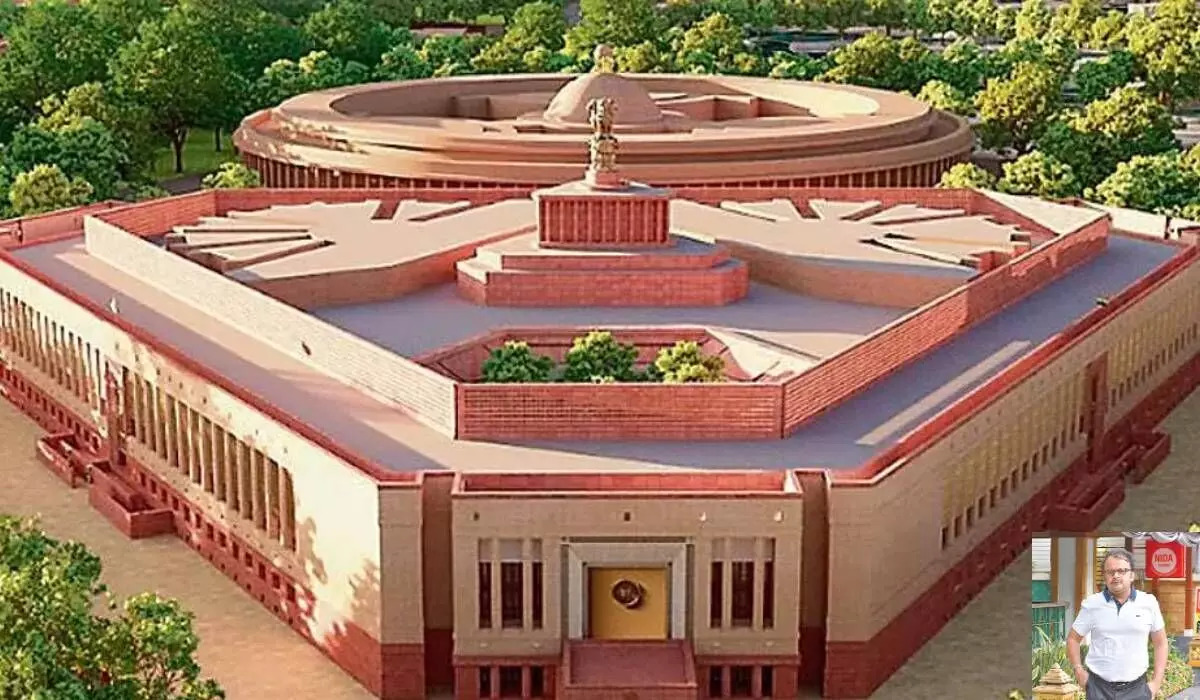Remember, do not forget those who built Parliament building
When you see either new or old parliament house, spare a thought for all those unknown workers who built it
image for illustrative purpose

Even as the new building of Indian Parliament was recently inaugurated, Surinder Ratawal, the ex cabinet minister of Delhi, was talking to his family about the making of Herbert Baker designed Parliament house (earlier Council house). The new building is just at a shouting distance from the one that was inaugurated by Viceroy Lord Irwin on January 18. Well, Ratawal has reason to discuss it as his grand-father and other family members came from Bharatpur in Rajasthan to build it. They were among the hundreds of unknown and faceless labourers who came to Delhi on foot to build the series of building that were coming up in 1920s including the Parliament house. “Alas, they were the footnotes of New Delhi history. My forefathers had spent their blood, sweat, tear and toil in order to build the behemoth Parliament House,” says Ratawal, 72, who was also the President of KM college students Union in 1971.
Cut to now. Hundreds of workers were on the job day and night to build the new Parliament House. They were working even when deadly second wave of Corona was devastating everything. When Delhi and the nation was confine to their homes, the work was without break.
However, this time modern machines too were there in building the Parliament. So, the new parliament house is built in less than 30 months. The first Parliament building's construction took six years – from 1921 to 1927.
Thanks to several factors the new Parliament house built fast. Actually, that was possible as the construction industry is changing rapidly, and new materials and technologies are being introduced on a regular basis. Execution of construction projects and their timely delivery has become a prime concern for the builders. Further, prefabricated or offsite construction has changed the face of construction scene. Well, it is the practice of assembling a variety of components of a structure at a manufacturing site and transporting them to the construction jobsite to be assembled. It is a mass-produced mode of construction. It requires meticulous planning and detailing as well as a greater eye for quality and precision.
Machines and technology apart, it is the labour of love of workers mainly from West Bengal, Jharkhand and Orissa who built it brick by brick. They were all employed by the contractor on a monthly salary of Rs 15 thousand, two times food and medical facilities. Some of them were ace plumbers and electricians too. Naturally, they were getting little more salary. After their work was finished, they moved to other sites, including Pragati Maiden and Minto Road.
Thousands of workers had descended in capital to complete various projects related to Central Vista and other projects. Surely, they would remain here even after completing their projects. This has been the trend since 1982. That was when mostly workers from Bihar came here. Of course, the numbers of Bihari workers have certainly gone down drastically this time.
Well, machines were not there when workers from mainly Bharatpur, Dholpur, Jaipur were building the Parliament on Raisina Hills. They used heavy stones of Dholpur manfully to create a magical building.
The very day when the Prime Minister Narender Modi had laid the foundation stone of new Parliament building on December 9, 2020, the work for creating a new building was started in a big way. It is part of the redevelopment of the Central Vista project revamping the three-km road from the Rashtrapati Bhavan to the India Gate, constructing a common central secretariat, a new office and residence of the Prime Minister, and a new vice-president enclave also part of the project being executed by the Central Public Works Department. If The Tata Projects Limited has built the parliament, it is designed by Ahmadabad based HCP Design, Planning and Management Private Limited.
And it was Lachhman Das, a Sindhi builder from Sindh now in Pakistan, built the Parliament House. Khushwant Singh in his essay ‘Romance of New Delhi’ describes him as a scrupulously honest man who did not use cheap material, paid his workers on time and didn't cheat on taxes. He adds that his honestly was his undoing and Lachhman Das retired to Haridwar, where he spent his last days as Sadhu. Khushwant Singh was not so kind even for his father, Sir Sobha Singh.
Ratawal says that those who came to build Parliament House were getting Rs one per day and their wives were paid 60 paise daily if they too working. “Lachhman Das used to spend time with workers and looked after their interests like father of the family. He was a very God-fearing character,” says Ratawal, who heard about him from his elders. The workers were given small plots to live in Karol Bagh area. Meanwhile, if workers were from mainly Rajasthan, the artisans were from mainly Agra and Mirzapur. They were experts on creating Jallies and Jharokas on stones. Their forefathers worked on the making of Jama Masjid and Red Fort. Surprisingly, those who are currently working in Delhi are not from Rajasthan. When you see either new or old parliament house, spare a thought for all those unknown workers who built it.
(The author is Delhi-based senior journalist and writer. He is author of Gandhi's Delhi which has brought to the forth many hidden facts about Mahatma Gandhi)

